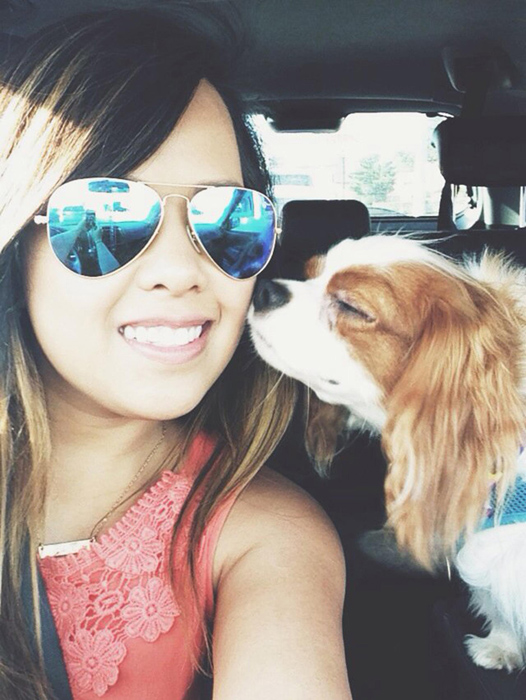An Ebola Tale with a Tail

At the U.S. Army Medical Research Institute of Infectious Diseases, the case number is known as SPL14.068. To Nina Pham, the subject has a different name: Bentley.
Bentley is Pham's two-year-old male Cavalier King Charles Spaniel dog. After Pham, a nurse in Dallas, contracted the Ebola virus from a patient, she was unsure of Bentley's fate. A nursing assistant's dog in Spain was euthanized after the woman contracted Ebola. Bentley's destiny, however, is a happier tale, thanks to the coordination of Dallas hospital administrators, the Centers for Disease Control and Prevention, and a group of Army researchers and veterinarians.
It just so happens that Lt. Col. Tony Alves, an Army veterinary pathologist assigned to the Defense Health Agency's Veterinary Services at the Defense Health Headquarters in Falls Church, Virginia, and a team of U.S. Army veterinarians across different specialties were already highly concerned about the limited scientific knowledge available concerning certain animals' roles, specifically dogs, in the transmission of Ebola to humans. Current scientific literature indicates that dogs may be asymptomatically infected with the Ebola virus. However, it remains unknown if dogs can shed the virus and, if so, for how long. Experts also wondered if asymptomatic dogs could be potential carriers. Alves knew military working dogs might deploy with military troops to support Operation United Assistance and knew there was a need for an Ebola diagnostic test in canines to screen military working dogs for Ebola upon redeployment.
"We really don't know how Ebola affects dogs, but we needed some sort of test to determine if a dog had been exposed to Ebola," explained Alves. "Military working dogs are valuable and proven force protection assets. Though we do not recommend military working dog deployment to Ebola outbreak areas at this time, we fully recognize that benefits to deploy may outweigh those risks."
Alves and others recognized that there was no diagnostic test proven to work on canines. A main reason is that diagnostic evaluation for Ebola must be conducted under special laboratory conditions, particularly Biosafety Level-4. In humans, the Department of Defense is currently using a test called the Ebola Zaire rRT-PCR Assay (i.e. test), developed by the USAMRIID and authorized for use in U.S. citizens by the DoD under DHHS-FDA's Emergency Use Authorization protocol. The Ebola Zaire virus is the strain of Ebola responsible for the 2014 West Africa outbreak. No one knew if the test would work on dogs.
To test the assay's ability to detect the Ebola virus in dogs, Alves coordinated the transport of blood samples to the USAMRIID from three different military working dogs collected during scheduled semi-annual physical examinations in late September 2014. All three military working dogs were healthy and none were exposed to the Ebola virus. Researchers at the USAMRIID, led by Dr. Mark Wolcott who is the director of the Special Pathogens Laboratory, used the blood samples, spiked with an irradiated strain of the Ebola virus, to determine if the assay test could detect the Ebola virus in canine samples. The test was equivalent to the level of Ebola virus detected in human blood samples.
Since September, the USAMRIID's Special Pathogens Laboratory has conducted screening for the Ebola virus in canine urine and feces samples with similar results. In fact, the veterinary communities are continuing to dialogue with the rest of the medical community to ensure adequate planning and response efforts are in place for veterinary-related issues with respect to the Ebola outbreak.
But what about Bentley, who was not a service dog but rather a pet and owned by a civilian? While the USAMRIID is not the referral laboratory for routine animal diagnostic testing for Ebola, Bentley's case proved to be an interesting opportunity to test an actual dog potentially exposed to the virus, explained Alves. Pets owned by service members are recognized and loved family members, said Alves. With the increased military presence in West Africa there remains the possibility, albeit highly unlikely, that the family pet may come in contact with a redeployed service member who has been laboratory confirmed positive for the Ebola virus.
Researchers at the Centers for Disease Control and Prevention were peripherally aware of the Ebola diagnostic screening conducted at the USAMRIID in support of the military working dogs and contacted Alves directly to determine if there was a remote possibility for testing samples collected from Bentley. In turn, Alves contacted the USAMRIID's Special Pathogens Laboratory. Following the USAMRIID's approval, coordination between Alves, the USAMRIID, the CDC and the Texas local, state, and federal health authorities began.
While Pham was in quarantined care at the National Institutes of Health in Bethesda, Maryland, Texas Animal Health Commission experts retrieved blood, urine and feces samples from Bentley, who was quarantined in Texas. The samples - collected at day seven and then again at day 18 of the 21-day quarantine-- were sent to the USAMRIID's Special Pathogen Laboratory for diagnostic screening for the Ebola Zaire virus using the standardized Ebola rRT-PCR protocol. While Bentley tested negative both times, he remained in quarantine for the full 21 days.
On Nov. 1, Pham and Bentley each got what they had been waiting for - a clean bill of health and a very emotional reunion.
"This was a very heartfelt story for all of us involved and would not have been possible without the coordinated efforts from our interagency colleagues, specifically at the CDC, and the dedicated local and state health and veterinary health authorities in Texas who obtained and submitted the samples under austere conditions," said Alves. "But more so, this success speaks volumes to Army medicine and the quiet, occasionally forgotten professionals who advance military medical research at places like the USAMRIID while rapidly responding to the changing needs of the mission. As we deploy service members overseas, we must do everything we can to protect our troops - to include our four-legged canine warriors."














